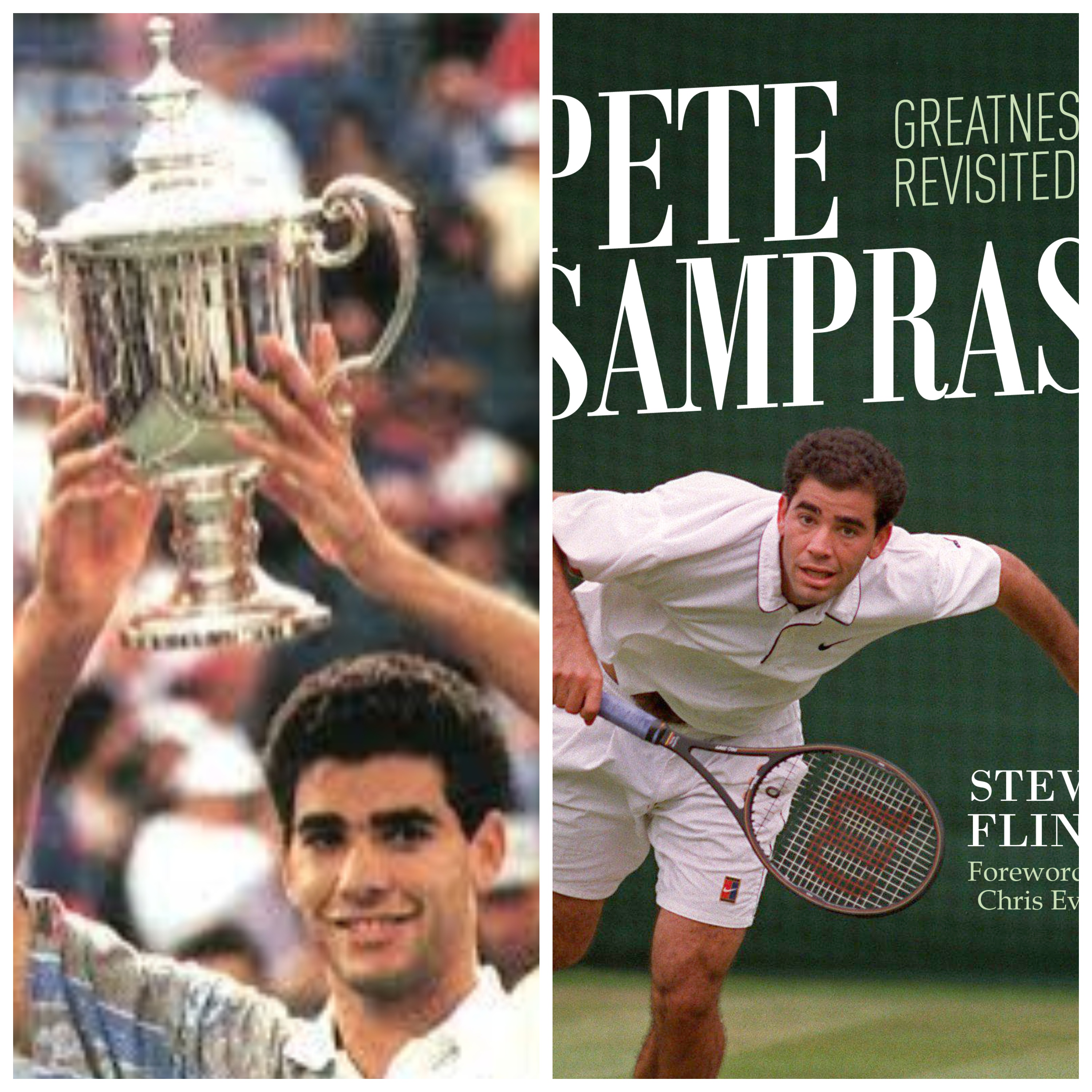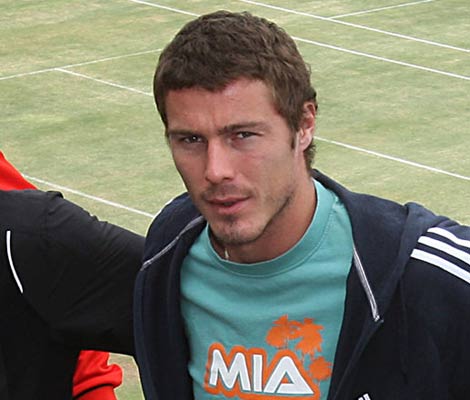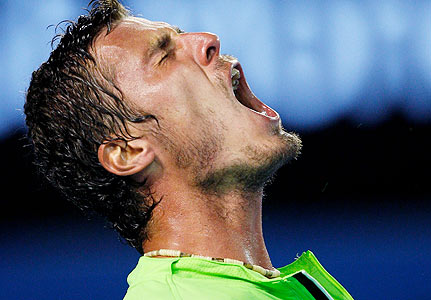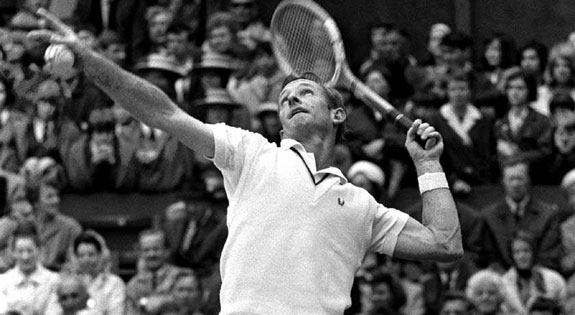After his historic break-through win at the 1990 U.S. Open at the age of 19, it took Pete Sampras a little while before he came to grips with his new found fame and adjust to being the all-time great player that he would become. He went through the next two years without winning his next major, which was at Wimbledon in 1993, a victory that was seen as the most important in his career, as you can read here: https://www.worldtennismagazine.com/archives/20956#:~:text=Sampras%20put%20an%20exclamation%20point,final%20match%20of%20his%20career. At the 1993 U.S. Open, he firmly cemented himself as the top player in men’s tennis – a mantle he would not get knocked off from for another 10 years.
Steve Flink reviews the Sampras win in Flushing Meadows in 1993, as well as all the major wins for “The Pistol,” in his book “Pete Sampras: Greatness Revisited” (for sale and download here: https://a.co/d/3Agm3b5 The excerpt from Chapter 5 of the book “The Class of the Field In New York” can be read below.
After pulling away inexorably against Chang in the 1993 Open quarters, Sampras had a semifinal meeting against Alexander Volkov. Sampras walked on court with clear notions of what he wanted to convey to his opponent from the opening bell. He served three consecutive aces in the first game. He would not face a break point over the course of the match, releasing 19 aces, making the low volleys look misleadingly easy. The Russian was seeded 14th and was at his career peak in the rankings. He had beaten Sampras on hard courts earlier in the season at Indian Wells. But Sampras was much too good for the left-hander on this occasion, moving swiftly into the final with a 6-4, 6-3, 6-2 victory.
Now Sampras was one match away from a second major title in a row as he took the court for the final on September 12, 1993. The only man standing between him and the crown was the Frenchman Cedric Pioline, an elegant shotmaker from France who was enjoying the finest fortnight of his life. The No. 15 seed had produced the upset of the tournament, toppling Jim Courier in the round of 16. Courier was the top seed at that Open because he had briefly recaptured the No. 1 position in the ATP rankings, but he was unable to contain the Frenchman, who found one opening after another to unleash flamboyant winners off his one-handed backhand while profiting from a subpar performance by the American.
Pioline had also ushered the 1988 champion Wilander out of that tournament. In the quarterfinals, he upended No. 8 seed Andrei Medvedev and, one round later, he accounted for the Australian Wally Masur. He had earned his place in the final at Flushing Meadows. But Pioline’s apprehension about facing Sampras was abundantly evident. He had lost to him twice in his career to date, and would never defeat the American in nine appointments across the nineties.
Right out of the gates, Sampras made his move. He broke Pioline in the opening game, taking advantage of a double fault from the Frenchman that put the underdog behind 15-40. Then Pioline served and volleyed and Sampras wisely sent his return down the middle, keeping it as low as possible. Pioline punched a backhand first volley long. The American had achieved the immediate break for 1-0. Although Sampras missed every first serve in the second game, he still held at the cost of only one point.
The 22-year-old American nearly broke again in the third game but Pioline erased a break point. Unswerving, Sampras moved briskly to 3-1, again losing only one point on serve. Both men held easily until Pioline served at 2-4, when he served-volleyed his way out of another break point. But he was merely delaying the inevitable. Sampras held at 30 for 5-3. Serving for the set in the tenth game, Sampras started with an ace and held at love to seal the 6-4 set in 37 productive minutes. In five service games, Sampras had won 20 of 24 points, backing up his delivery skillfully, giving Pioline cause for consternation.
Sampras commenced the second set just as he had done in the first, gaining a service break, this one on a double fault from a beleaguered Pioline. Serving at 30-40 in the second game, Sampras was broken for the first time in the match, netting a forehand first volley off a chipped return from Pioline. It was 1-1.
They went to 3-3, but Sampras was eager to reassert his authority, and he did just that. Pioline double faulted long at 30-40, allowing Sampras to advance to 4-3. Sampras served his tenth ace to open the next game, holding quickly for 5-3. Serving for the set in the tenth game, Sampras refused to let his guard down. At 30-15, Pioline sent a sizzling forehand passing shot up the line, but Sampras had blanketed the net, showing off his underrated agility, punching a backhand volley crosscourt into the clear. Staying back on his second serve at 40-15, Sampras was patient and purposeful. Pioline erred off his much more vulnerable forehand wing. The 6-4 set belonged to Sampras. The pattern continued. For the third set in a row, Pioline was broken in the first game, this time on consecutive double faults. But, as was the case in the second set, Sampras lost his serve from a break up, uncharacteristically double faulting twice as Pioline rallied to 1-1. It hardly mattered. That brief lapse was nothing more than that. Sampras resumed his mastery of the match briskly, breaking in the third game with consistently good returning off both sides.
Back ahead 2-1, Sampras was unstoppable the rest of the way. He took his next three service games with ease, winning 12 of 15 points in that span. Now Pioline was serving to stay in the match. The Frenchman saved one match point with a beautiful backhand stab finesse volley, but followed with a miss-hit backhand. Down match point for the second time, Pioline took himself out of his misery with a double fault. Sampras had forged a 6-4, 6-4, 6-3 victory for his third major title.
“I thought I played well,” reflected Sampras 25 years after confronting the Frenchman in New York. “Cedric was a good player but not quite a Courier. He didn’t play very well in that match against me at the Open. He was very talented but it was always windy out there in those days. Cedric had those big, long swings and he was shanking a couple of shots. I felt like I was on my game and I thought I was very efficient, serving well and doing what I do out there. My big win that year was over Michael. Volkov tended to throw in the towel every now and then. Against Cedric, I felt if I played well I should beat him and win the tournament and I was happy that happened.”
Coming into 1993, Sampras had deep concerns after not winning a major the two previous seasons. But succeeding at Wimbledon and the U.S. Open sent him into a new phase of his career as the man to beat, as indisputably the best player in the world, as the pace setter of the sport. Taking his second U.S. Open title two months after claiming his first crown at Wimbledon was absolute proof of his supremacy. Now he was right where he wanted to be, supremely confident about what he had already done, driven with quiet ferocity to keep going strong.
“Pete Sampras: Greatness Revisited” reviews the career and legacy of Sampras, who when he announced his retirement in 2003 was the most accomplished men’s tennis player of all time with a record 14 major singles titles. The Sampras career and legacy, however, became quickly overshadowed with the emergence of Roger Federer, Rafael Nadal and Novak Djokovic, all of whom surpassed the Sampras mark in a span of just over 16 years. Flink’s book, launched on the 30-year anniversary of the historic first major singles title for Sampras at the 1990 U.S. Open, re-examines the Sampras era and reminds readers of his dominance and excellence, focusing primarily on each major singles victory.
For the book, Flink extensively interviewed Sampras, who provided insight and perspective decades after his triumphs on the Grand Slam stages. The book also features perspectives and commentaries from Sampras rivals, coaches and tennis legends, including Novak Djokovic, Stefan Edberg, Goran Ivanisevic, Jim Courier, Patrick Rafter, Tom Gullikson, Martina Navratilova, Billie Jean King, Tracy Austin, Paul Annacone and Todd Martin among others.
“I felt compelled to write this book about a singularly commendable champion who set the highest ethical standards throughout a magnificent career,” said Flink. “Sampras was inspiring to me as a journalist who deeply valued his craftsmanship and authenticity— and immensely admired how he established himself as a quietly ferocious competitor and sportsman of the highest order.”
“Steve Flink is a tennis purist,” said Sampras in support of the book. “He followed my career as closely as any journalist. In this insightful biography, he shares his deep knowledge of tennis and writes with great clarity about me and how I approached my profession. Steve’s understanding of my game, my personality and my priorities is extraordinary.”
Six-time U.S. Open champion Chris Evert contributed the foreword to the book and wrote, “Steve is a great writer and historian and in this book he puts Pete’s career fully into perspective. I am sure you will enjoy reading this enlightening and comprehensive account about Pete Sampras, a very graceful champion and one of the greatest players any of us will ever see.”
Thirty years ago in 1990, at the age of 19 years and 28 days, Sampras became the youngest U.S. Open men’s singles champion with a 6-4, 6-3, 6-2 victory over Andre Agassi. Ten years later in 2000, Sampras won his record-breaking 13th major singles title, eclipsing the record for all-time men’s singles majors held by Roy Emerson, by beating Patrick Rafter 6–7 (10), 7–6 (5), 6–4, 6–2 in the Wimbledon final. Sampras put an exclamation point on his career at the 2002 U.S. Open when he defeatedAgassi 6–3, 6–4, 5–7, 6–4 to win his 14th career major singles title in a match that eventually became the final match of his career.
Flink is a tennis journalist and member of the International Tennis Hall of Fame who has covered more than 100 major tennis tournaments in his career. He is a columnist for TennisChannel and Tennis.com and also the author of the book “The Greatest Tennis Matches of All Time.” He is the former editor of World Tennis magazine and a former senior columnist at Tennis Week. He is a former varsity tennis player at Stetson University in Florida and now lives in Katonah, New York.
Founded in 1987, New Chapter Press (www.NewChapterMedia.com) is also the publisher of “Juan Martin del Potro: The Gentle Giant” by Sebastian Torok, “The Pros: The Forgotten Era of Tennis” by Peter Underwood, “The Greatest Tennis Matches of All-Time” by Steve Flink, “The Education of a Tennis Player” by Rod Laver with Bud Collins, “The Secrets of Spanish Tennis” by Chris Lewit, “The Bud Collins History of Tennis” by Bud Collins, “The Wimbledon Final That Never Was” by Sidney Wood, “Titanic: The Tennis Story” by Lindsay Gibbs, “Macci Magic: Extracting Greatness From Yourself And Others” by Rick Macci with Jim Martz, “Andy Murray, Wimbledon Champion: The Full Extraordinary Story” by Mark Hodgkinson, “Cattle To Courts: A History of Tennis In Texas” by Ken McAllister, “Sport of a Lifetime: Enduring Personal Stories From Tennis” by Judy Aydelott, “Trojan Tennis: A History of the Storied Men’s Tennis Program at the University of Southern California” by S. Mark Young, “Absolute Tennis: The Best And Next Way To Play The Game” by Marty Smith, “How To Permanently Erase Negative Self Talk So You Can Be Extraordinary” by Emily Filloramo, “Acing Depression: A Tennis Champion’s Toughest Match” by Cliff Richey and Hilaire Richey Kallendorf, “Your Playbook For Beating Depression: Essential Strategies For Managing and Living with Depression” by Cliff Richey and Mary Garrison, “Roger Federer: Quest for Perfection” by Rene Stauffer, “The Days of Roger Federer” by Randy Walker, “Jan Kodes: A Journey To Glory From Behind The Iron Curtain” by Jan Kodes with Peter Kolar, “Tennis Made Easy” by Kelly Gunterman, “On This Day In Tennis History” by Randy Walker, “A Player’s Guide To USTA League Tennis” by Tony Serksnis, “Court Confidential: Inside The World Of Tennis” by Neil Harman, “A Backhanded Gift” by Marshall Jon Fisher, “Boycott: Stolen Dreams of the 1980 Moscow Olympic Games” by Tom Caraccioli and Jerry Caraccioli (www.Boycott1980.com), “Internet Dating 101: It’s Complicated, But It Doesn’t Have To Be” by Laura Schreffler, “How To Sell Your Screenplay” by Carl Sautter, “Bone Appetit: Gourmet Cooking For Your Dog” by Suzan Anson, “The Rules of Neighborhood Poker According to Hoyle” by Stewart Wolpin among others.




